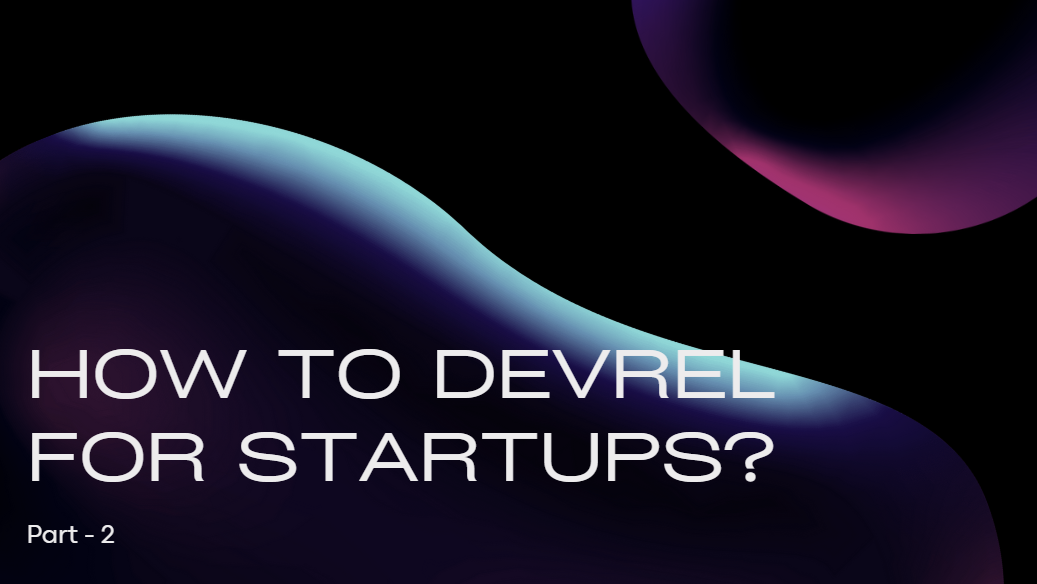How to DevRel for Startups: Part 2
 Isha Parekh
Isha Parekh
Building a community from scratch? Educating developers? Launching on Product Hunt? Sounds overwhelming, right? But trust me - DevRel isn’t rocket science (unless you’re literally working on rockets). It’s about engagement, education, and execution. Let’s break it down so you don’t have to learn the hard way.
How to Build a Community from Scratch
A great community isn’t just a nice-to-have; it’s a superpower for startups. Here’s how a strong community helps you:
Faster Product Feedback – Your users tell you what works (and what’s broken, loudly).
Brand Awareness – People talk. Give them something worth talking about.
Growth & Retention – New users join, old users stay.
Support that Scales – Your community can help each other.
Building a developer community is like starting a band. You need a vision, find your people, and create something worth sticking around for.
The Blueprint for Building a Community
Define a Vision – What’s your North Star? A strong community starts with a clear mission. Otherwise, it’s just a group chat with extra steps.
Find Your People – Identify your early adopters. The ones who actually care. Not just the ones who show up for free swag.
Pick the Right Channel – Whether it’s Discord, Twitter, or a forum, give people a place to hang out (and occasionally complain about your product).
Track Engagement – Track engagement, not just numbers. A 100 engaged users > 10,000 lurkers.
Create Valuable Resources – Make it easier for people to get involved. FAQs, Guides, docs, templates, onboarding guides, and a welcome post that isn’t just “hey everyone 👋.”
Make It Fun – Because nothing motivates developers like points, leaderboards, and exclusive badges.
Common Community-Building Mistakes
Copy-Pasting Another Community – What works for them might not work for you. Adapt!
Chasing Only Revenue – Community is built on relationships, not just sales. A transactional community won’t last.
Overplanning, Under executing – Sometimes, you just need to launch and iterate. Get started, tweak later.
How to Strategize Community-Led Growth (CLG)
People don’t just wake up and decide to use your product. They trust recommendations. 92% of consumers (yes, developers are consumers too) are influenced by what others say.
How to Drive Growth Through Community
Build an Engaged Online Community – People need a space to connect.
Create Community Advocates – Loyal members = free marketing. Your biggest fans should be your loudest voices.
Offer Helpful Content – Educate first, sell later.
Content is King – Blogs, tutorials, and documentation should not put people to sleep.
Developer Experience: The Art of Good Documentation
Developers don’t read documentation. Until they have to. And when they do, it better not suck.
Golden Rules of Documentation
Know Your Audience – Who’s reading this? Are they beginners? Experts? Write accordingly.
Keep It Simple – Avoid unnecessary complexity. No one wants to read a novel to make an API call.
Minimize Friction – Let developers test without endless setup. Cut unnecessary setup steps.
Be Thorough – Good docs answer every question before it’s asked.
Make It Detailed – But not too detailed. Balance is key.
The Developer Journey
Devs don’t just magically land on your tool and stick around. They go through five stages:
Discovery – “What is this?”
Evaluation – “Is this worth my time?”
Learning – “How does this work?”
Building – “Let’s integrate this.”
Scaling – “This is part of my workflow now.”
Your job? Make sure they don’t drop off before Stage 5. that means understanding dev sentiment, fixing gaps, and actually listening to feedback.
Developer Education: Crafting a Content Strategy
A good content strategy isn’t about cranking out blog posts. It’s about delivering value in the right format at the right time, it teaches, inspires, and makes people want to use your product. Here’s the breakdown:
Key Pillars of Developer Education
Creation – Quality over quantity.
Delivery – Right content, right platform.
Governance – Keep things structured.
Different Learning Approaches
Not all developers are the same! Some are beginners, others are advanced. Offer:
On-Demand, Modular Content
Links to Advanced Resources
Smooth, Step-by-Step Learning Paths
Ways to Scale Developer Education
Partner with educational institutions
Leverage the creator economy
Utilize certifications & platforms like Udemy
Collaborate with corporate trainers
Measuring Success: The DevRel Numbers That Matter
If you’re not tracking, you’re guessing. And guessing doesn’t grow startups. DevRel success isn’t about vanity metrics it’s about real impact.
What to Measure in DevRel
Community Growth – Active members & engagement.
Documentation Effectiveness – Page views, feedback.
Active Users – Are people actually using your product?
Free Trial Conversions – Do users turn into paying customers?
Feedback Loops – What’s making users stay (or leave)?
Measuring DevRel isn’t a last-minute task. Start tracking from Day 1.
How to Do a Successful Product Hunt Launch
What’s a startup without a Product Hunt launch? Incomplete. That’s what.
Is Product Hunt Still Worth It?
You’ve seen the “Product Hunt is dead” posts. Spoiler alert: It’s not. It’s still an awesome launchpad if you do it right.
How to Win Product Hunt
Have a Killer Product – No amount of marketing saves a bad product.
Get Early Adopters – Build a waitlist, gather interest.
Create a Launch Checklist – Don’t wing it.
Make High-Quality Assets – GIFs, videos, mockups.
Pick the Right Time – Timing matters!
Tease the Launch – Hype it up!
Engage Your Community – Let them champion your launch.
Final Thoughts
DevRel is about building relationships, not just products. Whether it’s through community, education, or a killer Product Hunt launch. Success comes from engagement, iteration, and delivering real value.
So, don’t overthink it. Start, experiment, tweak, and grow.
Subscribe to my newsletter
Read articles from Isha Parekh directly inside your inbox. Subscribe to the newsletter, and don't miss out.
Written by

Isha Parekh
Isha Parekh
Building in public